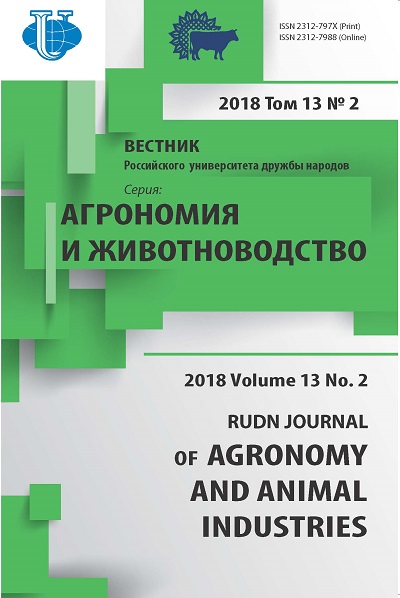Research of influence of various methods of crops zhitnyaka on efficiency of the improved pastures in the arid zone of Northern Prikaspiya
- Authors: Bulakhtina GK1, Kudryashov AV1, Kudryashova NI1, Tumanyan AF2, Terekhin AA2
-
Affiliations:
- Caspian Research Institute of Arid Agriculture
- Peoples’ Friendship University of Russia (RUDN University)
- Issue: Vol 13, No 2 (2018)
- Pages: 103-112
- Section: Crop production
- URL: https://agrojournal.rudn.ru/agronomy/article/view/18683
- DOI: https://doi.org/10.22363/2312-797X-2018-13-2-103-112
- ID: 18683
Cite item
Full Text
Abstract
Article tells that experiment of crops of a Agropyrum for improvement of an unproductive pasture is made. Agropyrum - the most perspective fodder culture possessing steady harvests, high fodder advantages is steady against salty lands, durability, drought resistance and winter hardiness which is used for improvement of natural fodder grounds in arid regions of Russia. The sowed material - mix of three types Agropyrum: Siberian (Agropyrum Sibiricum, Willa), desert (Agropyrum desertozum, Figeh) and pectineal (Agropyrum pectiniforme, Sehuet), the pastures of the Astrakhan region collected on natural the sukhostepnykh. The purpose of researches - to study influence of sowing time (autumn, spring) and the directions of crops (the North-South, the West-East) of a Agropyrum on efficiency of a new pasture in arid conditions of Northern Prikaspiya. When carrying out researches popular methods of crops and a research of pastures have been used. Results of researches have shown: seeds of different types of a Agropyrum were similar on the weight and viability; at crops in the spring in the first year of life the most part of a new pasture was occupied by different herbs, and at autumn crops - the most part of a pasture was occupied Agropyrum; crops with the direction the West-East were optimum for development of herbs on a new pasture since the harvest at crops was more in the spring, than a crops harvest with the direction the North-South on 0,5 tons from 1 hectare, and at autumn sowing time - on 0,9 tons from 1 hectare (according to the second year of life of a Agropyrum); autumn sowing time - optimum for crops of a Agropyrum at restoration of arid pastures because the productivity of a new pasture (the second year of life of a Agropyrum) was higher, than at crops in the spring on 0,8 tons from 1 hectare (at the direction of crops the West-East) and on 0,4 tons from 1 hectare (North-South). Thus, at the first stage of long-term experience we have created new agronomical ecosystems - the improved arid pastures and have reached in two years of their higher efficiency in comparison with natural steppe ecosystems. At the following stages researches of stability of these agronomical ecosystems, including their longevity and maintaining efficiency are planned.
About the authors
G K Bulakhtina
Caspian Research Institute of Arid Agriculture
Author for correspondence.
Email: gbulaht@mail.ru
-
v. Salt Zaymishche, quarterNorth, Chernoyarsky district, Astrakhan region, Russia, 416251A V Kudryashov
Caspian Research Institute of Arid Agriculture
Email: stone75@list.ru
-
v. Salt Zaymishche, quarterNorth, Chernoyarsky district, Astrakhan region, Russia, 416251N I Kudryashova
Caspian Research Institute of Arid Agriculture
Email: stone79.79@list.ru
-
v. Salt Zaymishche, quarterNorth, Chernoyarsky district, Astrakhan region, Russia, 416251A F Tumanyan
Peoples’ Friendship University of Russia (RUDN University)
Email: aftum@mail.ru
-
Miklukho-Maklaya st., 6, Moscow, Russia, 117198A A Terekhin
Peoples’ Friendship University of Russia (RUDN University)
Email: terekhin_aa@rudn.university
-
Miklukho-Maklaya st., 6, Moscow, Russia, 117198References
- Koshkin A.V. The state and character of animal husbandry as a factor in the well-being of some steppe species of birds. The Russian Journal of Ornithology. 2015; 39: 44—47.
- Smelansky I.E., Tishkov A.A. The steppe biome in Russia: ecosystem services, conservation status, and actual challenges. Eurasian Steppes. Ecological problems and livelihoods in a changing world. Springer. 2012; 45—101.
- Shamsutdinova E., Starshinova O., Shamsutdinov Z. Galofitnoye rasteniyevodstvo: kontseptsiya. opyt. Perspektivy. Dostizheniya nauki i tekhniki APK. 2013; 11: 36—39.
- Shamsutdinov Z. Printsipy i metody biologicheskoy melioratsii degradirovannykh zemel. Pochvennyye resursy Prikaspiyskogo regiona i ikh ratsionalnoye ispolzovaniye v sovremennykh sotsialno-ekonomicheskikh usloviyakh. Astrakhan: 1994; 32—34.
- Zvolinskiy V.P. Dikorastushchiye kormovyye rasteniya i ikh rol v povyshenii produktivnosti aridnykh pastbishch Severnogo Prikaspiya. Sbornik “Agrotekhnologiya i nauchnoye obespecheniye intensivnogo zemledeliya Nizhney Volgi na sovremennom etape”. Moscow: “Sovremennyye tetradi”. 2005; 312—327.
- Romanenko G. Kormovyye rasteniya Rossii. Moscow: TsINAO; 1999; 168—169.
- Komarova V. Flora SSSR Tom II. Moscow: 1941.
- Iglovikov V. Metodika opytov na senokosakh i pastbishchakh. In-t Kormov im. Viliamsa V.R.; 1971.
- Dospekhov V. Metodika polevogo opyta. Moscow: Agropromizdat; 1985.
- Shagaipov M. Korennoye uluchsheniye pastbishchnykh ugodiy Astrakhanskoy oblasti. Moscow: Vestnik Rossiyskoy akademii selskokhozyaystvennykh nauk; 2009.
- Chernikov V. Ustoychivost pochv k antropogennomu vozdeystviyu. Pushchino: Mosk. s.-kh. akad. im. K.A. Timiryazeva; 2001.
Supplementary files















